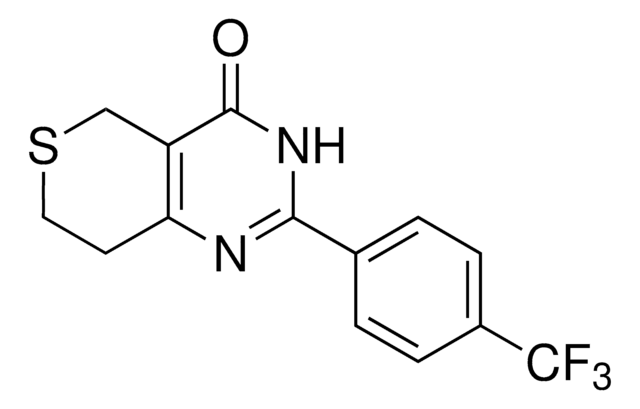추천 제품
product name
JAK Inhibitor I, JAK Inhibitor I, CAS 457081-03-7, is a potent, reversible, cell-permeable, and ATP-competitive inhibitor of JAK 1 (IC₅₀ = 15 nM), JAK2 (IC₅₀ = 1 nM), JAK3 (Ki = 5 nM) and Tyk2 (IC₅₀ = 1 nM).
Quality Level
분석
≥98% (HPLC)
형태
solid
제조업체/상표
Calbiochem®
저장 조건
OK to freeze
protect from light
색상
off-white
solubility
DMSO: 5 mg/mL
배송 상태
ambient
저장 온도
−20°C
InChI
1S/C18H16FN3O/c1-18(2,3)17-21-14-10-5-4-9(19)8-12(10)13-11(15(14)22-17)6-7-20-16(13)23/h4-8H,1-3H3,(H,20,23)(H,21,22)
InChI key
VNDWQCSOSCCWIP-UHFFFAOYSA-N
일반 설명
A potent, cell-permeable, reversible, and ATP-competitive inhibitor of Janus protein tyrosine kinases (JAKs). Displays potent inhibitory activity against JAK1 (IC50 = 15 nM for murine JAK1), JAK2 (IC50 = 1 nM), JAK3 (Ki = 5 nM), and Tyk2 (IC50 = 1 nM). Inhibits other kinases at much higher concentrations. Shown to inhibit IL2- and IL4-dependent proliferation of CTLL cells and block the phosphorylation of STAT5, and further induce growth inhibition of multiple myeloma cells expressing activated JAKs and STAT3, unlike AG 490 (Cat. No. 658401).
A potent, reversible, cell-permeable, and ATP-competitive inhibitor of Janus protein tyrosine kinases (JAKs). Displays potent inhibitory activity against JAK1 (IC50 = 15 nM for murine JAK1), JAK2 (IC50 = 1 nM), JAK3 (Ki = 5 nM), and Tyk2 (IC50 = 1 nM). Inhibits other kinases at much higher concentrations. Shown to inhibit IL2- and IL4-dependent proliferation of CTLL cells and block the phosphorylation of STAT5; and further induce growth inhibition of multiple myeloma cells expressing activated JAKs and STAT3, unlike AG 490 (Cat. No. 658401). A 10 mM (500 µg/162 µl) solution of JAK Inhibitor I (Cat. No. 420097) in DMSO is also available.
생화학적/생리학적 작용
Cell permeable: yes
Primary Target
murine JAK1
murine JAK1
Product competes with ATP.
Reversible: yes
Target IC50: 15 nM against murine JAK1; 1 nM against JAK2; 1 nM against Tyk2
Target Ki: 5 nM against JAK3
포장
Packaged under inert gas
경고
Toxicity: Standard Handling (A)
재구성
Following reconstitution aliquot and freeze (-20°C). Stock solutions are stable for up to 3 months at -20°C.
기타 정보
Pedranzini, L., et al. 2006. Cancer Res.66, 9714.
Lucet, I.S., et al. 2005. Blood107, 176.
Thompson, J.E., et al. 2002. Bioorg. Med. Chem. Lett.12, 1219.
Lucet, I.S., et al. 2005. Blood107, 176.
Thompson, J.E., et al. 2002. Bioorg. Med. Chem. Lett.12, 1219.
법적 정보
CALBIOCHEM is a registered trademark of Merck KGaA, Darmstadt, Germany
Storage Class Code
11 - Combustible Solids
WGK
WGK 3
Flash Point (°F)
Not applicable
Flash Point (°C)
Not applicable
시험 성적서(COA)
제품의 로트/배치 번호를 입력하여 시험 성적서(COA)을 검색하십시오. 로트 및 배치 번호는 제품 라벨에 있는 ‘로트’ 또는 ‘배치’라는 용어 뒤에서 찾을 수 있습니다.
이미 열람한 고객
Pratap Karki et al.
Cellular signalling, 53, 246-255 (2018-10-20)
Exposure to particulate matter (PM) associated with air pollution remains a major public health concern, as it has been linked to significant increase in cardiopulmonary morbidity and mortality. Lung endothelial cell (EC) dysfunction is one of the hallmarks of cardiovascular
Ian C Henrich et al.
Cancer research, 81(8), 2171-2183 (2021-02-10)
Ewing sarcoma is the second most common pediatric bone cancer, with a 5-year survival rate for metastatic disease of only 20%. Recent work indicates that survival is strongly correlated with high levels of tumor-infiltrating lymphocytes (TIL), whose abundance is associated
Fuyuko Takata et al.
Journal of cellular biochemistry, 119(11), 9055-9063 (2018-08-05)
Oncostatin M (OSM) is a member of the interleukin (IL)-6 family cytokines. We previously demonstrated that OSM induces blood-brain barrier (BBB) impairment. However, functional characterization of IL-6 family cytokines in BBB regulation and the cytokine-related intracellular signaling pathway remain unclear.
Elizabeth I Vink et al.
Proceedings of the National Academy of Sciences of the United States of America, 118(45) (2021-11-03)
In addition to being required for protein synthesis, ribosomes and ribosomal proteins (RPs) also regulate messenger RNA translation in uninfected and virus-infected cells. By individually depleting 85 RPs using RNA interference, we found that overall protein synthesis in uninfected primary
Chi-Shuan Fan et al.
Cells, 11(2) (2022-01-22)
M2-polarization and the tumoricidal to tumor-promoting transition are commonly observed with tumor-infiltrating macrophages after interplay with cancer cells or/and other stroma cells. Our previous study indicated that macrophage M2-polarization can be induced by extracellular HSP90α (eHSP90α) secreted from endothelial-to-mesenchymal transition-derived
자사의 과학자팀은 생명 과학, 재료 과학, 화학 합성, 크로마토그래피, 분석 및 기타 많은 영역을 포함한 모든 과학 분야에 경험이 있습니다..
고객지원팀으로 연락바랍니다.








